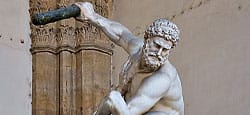Despite its somewhat removed position with respect to the square, the arcade called “Loggia della Signoria”, known also as the Loggia dei Lanzi, is one of the city’s major points of interest and prestige. Created as a roof to host popular assemblies in the open air, this space has since been transformed into an exceptional outdoor museum when, during the 1500s, certain masterpieces of sculpture were exhibited here. This fascinating place, like a fence that protects a crowd of immobile actors, exerts an irresistible attraction and wherever you are in the piazza, you can’t help but walk over and take a look inside.
The arcade takes its name from the Landsknechts (Lanzichenecchi in Italian) the infamous mercenary corp that bivouacked under these arches before moving on to ransack Rome in 1527. It was designed by Simone Talenti in late Gothic style towards the end of the 1300s, but his use of round arches makes it one of the first examples of Renaissance architecture in Florence; it seems that even Brunelleschi was inspired by it for the design of what is considered to be the first fully Renaissance building, the “Spedale degli Innocenti”.
The aspects of its architecture are elegant and essential. In the upper portion of the facade, the four medallions between the wide arches represent the cardinal virtues. The terrace above the Loggia, now part of the Uffizi Gallery, was created by Bernardo Buontalenti to allow the people to watch ceremonies being held in the piazza from above. Today, it is part of the museum bar and is a perfect spot to catch a panoramic view.
Two stone lions – one from ancient Rome, the other from the 17th century – seem to guard the entrance from the sides of the stairway. Their presence, at the same time menacing and reassuring, gives the impression of entering a sacred place.
The loggia contains several ancient masterworks. Patroclus and Menelaus, copy of an original Greek statue, are from the Flavian era, and the six female figures on the back wall probably come from Trajan’s Forum in Rome and were part of the decorative scheme of Villa Medici. Two of these, made out of rare marble, surely represent two matrons of a high, perhaps imperial social level.
In the second half of the 16th century, Cosimo I de’ Medici ordered the Loggia changed into a sort of sculptors workshop, a place where one could admire great works of art. The idea was also a political one: the sculptures were to celebrate the definitive victory of the Granduchy over the republican institutions of the city. So the loggia truly became an exhibition space reserved for sculpture and, as open-air museum, is the only place that you can visit free. Every statue here had to symbolize some part of Florence’s history, each, of course, with its own precise political reference.
In 1850, a thermometer and a barometer were attached to the back wall of the arcade: they were supposed to have teaching functions, to demonstrate scientific measurement to the public, but they were judged to be out of place with respect to the value of the monumental loggia and were soon removed. Finally, a curiosity: on the walls are two commemorative inscriptions that recall the adoption of the common calendar, which occurred in Florence in 1750 and all the stops along the path of unification of Italy.



